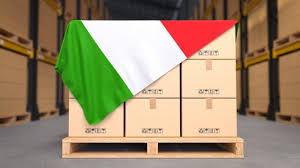Ukraine – Italy: analytical trade review

Rome: Although Ukrainian exports to Italy have decreased due to the war, the country remains an important market for the products of the agro-industrial complex and steel sector.
For example, the Italian market is important for Ukrainian steel industry as a consumer of semi-finished products of Metinvest Group’s enterprises. Moreover, the company already has its rolling mills – Ferriera Valsider and Metinvest Trametal – and plans to expand its presence in this market.
Compared to pre-war 2021, exports of Ukrainian products to Italy in physical terms fell by 36% – to 4.9 million tons, in monetary terms – by 56%, to $1.5 billion in 2023. At the same time, exports in tons recovered last year compared to 2022 and grew by 35%.
In turn, over the same period, Italian imports of goods to Ukraine decreased by 23% – to 0.4 million tons in physical terms, while in monetary terms – by only 15%, to $2.3 billion. Last year, compared to the previous year, it increased in monetary terms by 26%.
Analyzing the weight and value of commodity flows, we see a traditional picture – Ukraine supplies agro raw materials and semi-finished products, and receives goods with high added value.
The largest imports from Italy are tobacco products ($231 million), medicines ($127 million) and petroleum products ($112 million). In smaller, but significant volumes in 2023 were supplies to Ukraine of food and wine, consumer goods, industrial raw materials, tools, appliances and machinery.
Italy was a major consumer of Ukrainian agro-products even before 2022, but its importance as a market for agro-industrial products has increased due to the ban on exports to most neighboring countries, despite the decline in shipments. The largest items of Ukrainian exports in 2023 were corn ($447 million), steel products ($244 million), sunflower oil ($232 million), wheat ($102 million) and soybeans ($61 million). There are also insignificant supplies of food products, wood products and industrial raw materials.
Analyzing the weight and value of commodity flows, we see a traditional picture – Ukraine supplies agro raw materials and semi-finished products, and receives goods with high added value.
The largest imports from Italy are tobacco products ($231 million), medicines ($127 million) and petroleum products ($112 million). In smaller, but significant volumes in 2023 were supplies to Ukraine of food and wine, consumer goods, industrial raw materials, tools, appliances and machinery.
Italy was a major consumer of Ukrainian agro-products even before 2022, but its importance as a market for agro-industrial products has increased due to the ban on exports to most neighboring countries, despite the decline in shipments. The largest items of Ukrainian exports in 2023 were corn ($447 million), metal products ($244 million), sunflower oil ($232 million), wheat ($102 million) and soybeans ($61 million). There are also insignificant supplies of food products, wood products and industrial raw materials.
Due to the loss of two steel mills in Mariupol, which before the war were mainly used for Ukrainian exports, the volume of steel products exported to Italy has fallen dramatically. Exports of iron and steel products from Ukraine in 2023 compared to pre-war 2021 in physical terms fell to 513 thousand tons from 3.4 million tons, in monetary terms – to $244 million from $2.2 billion. Complex logistics (until the opening of the sea corridor in the middle of last year) also hampered mass deliveries.
Before the war, the most massive export item was steel semi-finished products, with shipments of 1.9 million tons worth $1.3 billion in 2021, consumed by Ferriera Valsider and Metinvest Trametal rolling mills, which are part of Metinvest Group. The loss of slab suppliers – Ilyich Iron and Steel Works and Azovstal – led to a drop in exports of semi-finished products to Italy to 121,000 tons ($58 million) in 2023. In this regard, Metinvest had to restructure its processes and start buying slabs from European producers – Adi, ThyssenKrupp, Liberty Galati and US Steel Kosice, as well as in China and Brazil.
The most massive export item is iron ore, shipments of which in 2022 sharply declined to 36,000 tons from 370,000 tons in 2021, but partially recovered at the end of last year to 154,000 tons.
Italy is the «weak link» in the EU sanctions policy, particularly with regard to the Russian steel industry. The country remains interested in the continued supply of Russian semi-finished products, on which the work of local steel plants depends. As a consequence, while the EU prohibits access of steel products from Russia to its market, Italy is increasing its consumption of Russian products. Last year, compared to pre-war 2021, Italy increased its consumption of Russian pig iron by 2.8 times – up to 1.2 million tons, slabs – by 66%, up to 724 thousand tons.
The increase in supplies of Russian products was due to the reduction of supplies from Ukraine. Accordingly, the displacement of Russian products from the European and Italian market will be facilitated by the launch of new production facilities in the EU, which would operate on Ukrainian raw materials and could replace Russian semi-finished products. In this case, Italian steel enterprises would retain their competitiveness and there would be no need to lobby for imports from Russia.
Compared to pre-war 2021, imports of steel products from Italy in physical terms increased 4 times to 40 thousand tons, in monetary terms – 2.4 times to $66 million in 2023. After the start of the war, supplies of hot-rolled steel products from Italy started, which increased from zero to 30 thousand tons. This represents 3.7% of the total consumption of these products in 2023. Supplies of other types of steel products do not exceed 2-3 thousand tons.
Italian steel imports to Ukraine account for only 3.2% of total steel imports, or 1.1% of Ukraine’s steel consumption in 2023. Therefore, imports of steel products from Italy are unlikely to become significant for the Ukrainian market in the foreseeable future. At the same time, it was supplies from Italy that partially solved the problem of plate steel shortage, which appeared on the Ukrainian market after the war started.
Italy is a major steel producer, ranking 11th in the world in terms of melted steel production. Italy’s steel production in 2023 accounted for 16.7% (15.8% in 2022) of EU steel production. However, following the pan-European trend, production levels have been declining recently. According to WorldSteel, last year the country reduced steelmaking by 2.4% y/y – to 21.1 million tons, while the decline in 2022 was 11.6% y/y – to 21.6 million tons.
Thanks to its developed industry, the country has a high level of steel consumption – in 2021 and 2022 it amounted to 26.6 million tons and 25.1 million tons, respectively. At the same time, Italy is actively trading in steel products. Amid steel exports of 16 million tons in 2022, imports amounted to 20.2 million tons.
Given the large domestic market and existing assets, Metinvest plans to expand its presence in the local market by constructing a plant in Tuscany to produce 3 million tons of green steel per year. The project implementation is expected to take 2-3 years, and the plant will be able to start production in 2027.
Metinvest planned to open a new production facility even before the war. At that time it was expected that the new plant would use semi-finished products from Azovstal, but after the destruction of the steel mill the plans had to be reformatted. Now the company expects that the future Italian plant will use iron ore products from Ukraine as raw materials.
Italy is a major market for only a few types of export products of Ukrainian agro-industrial complex and steel sector. However, given the ban on exports of agro-industrial products to many neighboring countries, the importance of the Italian market for Ukrainian agro-products (corn, sunflower oil, wheat) may grow.
Ukraine has a theoretical potential to increase supplies of steel products, which is limited by uncertain prospects for increasing domestic production of slabs and pig iron. Therefore, Metinvest’s intentions to increase iron ore supplies by creating new capacities in Italy look perfectly justified, although this is a medium-term prospect.
Thus, under current conditions, the most important for the Ukrainian economy is the export of agro- and steel products to Italy, which requires stable operation of the sea corridor and Danube ports.





